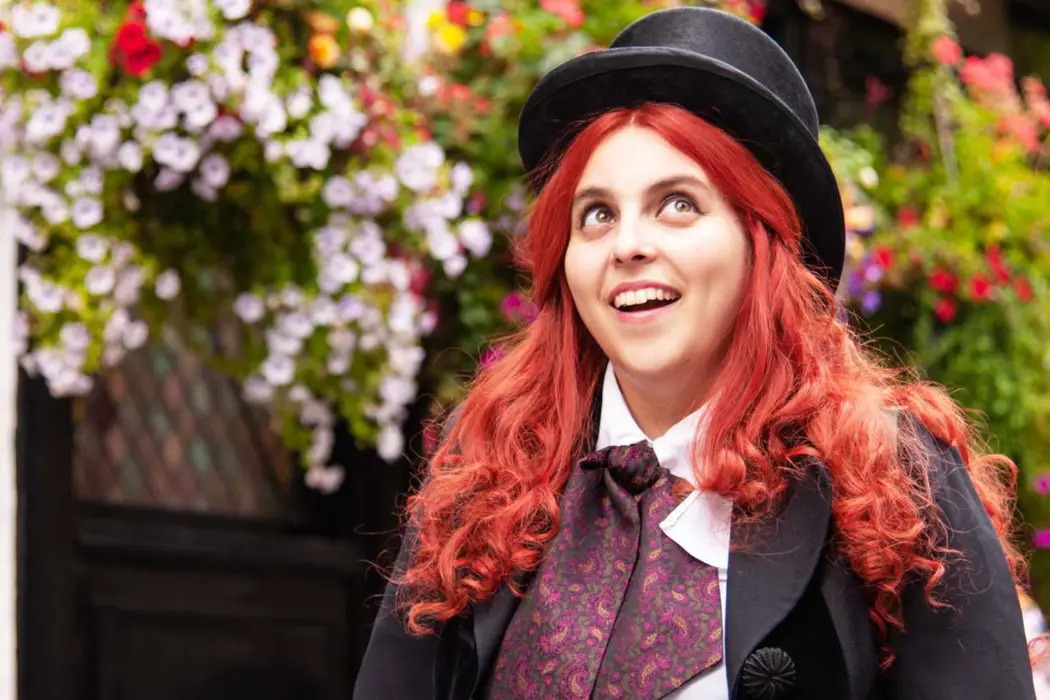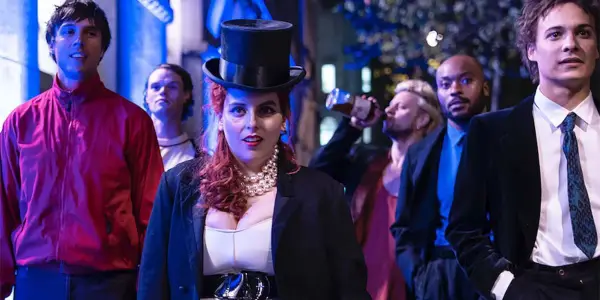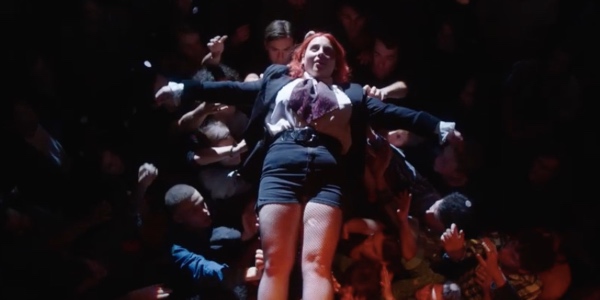HOW TO BUILD A GIRL: Sometimes You Need To Be The Villain of Your Story

Stephanie Archer is 39 year old film fanatic living in…
“Write one true thing”. As the film ends on this idea of writing one true thing, saying one true thing, I find myself facing the same moment as I sit in front of my computer preparing to write this review. And my one true thing – I really loved How to Build A Girl. It is empowering and inspiring, all while being an endearing film that is sure to satisfy the masses. Sure, there are moments and elements that ask the audience to stretch their imagination, to just enjoy the ride, but the ride is worth it. In a time when women are breaking boundaries and recreating the ideas and perspectives of female characters, How to Build A Girl delivers just that.
Yes, this may seem like hockey little, run of the mill coming of age film, but it is far from it. There are a depth and a richness to its story – one that will fit a modern age and is one for the ages to come.
Plot
As How to Build A Girl opens, there is a familiarity that instantly takes hold of viewers. The light and airy nature to the opening scene calls instantly back to the films of Gary Marshall (specifically The Princess Diaries – both in style and design), the environment, situation and protagonist delivered instantly in a recognizable mise en scène and with heart. There is a caring caress in the opening, a creator truly taking care to introduce her latest inspiration.
An aspiring writer, Johanna Morrigan (Beanie Feldstein) is waiting for her “moment”. Every girl in the books she loves has a life-altering “moment” that changed their futures forever. While her imagination takes hold, burst by the bells of reality, the only certainty that Johanna has is that her adventure will not start with a boy, but rather herself. This early acknowledgment if the foundation for How to Build a Girl, one that is clearly understood through each facet of storytelling – both the good and the bad.

When Johanna wins a local poetry contest, she believes that her “moment” has finally come – only to find her potential adventure has been blocked by her own lack of self-confidence. Feeling as though the end of her dreams has come, her brother alerts her to a local advertisement looking for a young and fresh rock critic to join the ranks of DME. Jumping at the chance, she decides her first piece will be a critique of Annie’s “The Sun Will Come Out Tomorrow” – a submission fitting her bright personality, but one that has her “moment” turned into despair. Yet, as she sees her future vanishing, Johanna does exactly as she stated in the beginning – she begins her adventure with herself.
She demands a chance and an assignment, stunning the seemingly all-male staff, obtaining her first assignment, a new love and life-changing success. Yet, with success comes moments of morality – and deciding where that line is drawn. As she begins down the dark path of delinquency, slander and downright bitchy-ness, Johanna finds the adventure she made for herself may destroy her future.
Building A Girl
Based on the novel by Caitlin Moran and directed by Coky Giedroyc, How to Build A Girl is a coming of age story that speaks to generations both past, present and future. It is a film parents will find themselves enjoying along with their teens. If I was to write another “one true thing” – this is a film I would love to watch with my mother – both as a teen and currently. From the moment it opened, the nostalgic feeling of the coming of age films I had grown up with quickly drew me in, yet it also quickly evolved becoming a cinematic tale all its own.
One of the biggest successes was with the inclusion of Johanna’s imagination and bringing it to life. From the very beginning, the world around her is changed, even for a moment, as she allows herself to imagine a variety of boys showing interest in her through the school’s library window. While this is short-lived, and not how her adventure begins, it is a subtle nod to the coming of age stories before that focused on the discovery of relationships. It is also a moment when How to Build a Girl show what it truly wants to be. The imagination element continues to evolve as we continue on, the authors of her favorite literary works (played by a variety of cameo favorites, including Michael Sheen, Lucy Punch, and Sue Perkins) lining the walls of her bedroom coming to life, reacting and responding to Johanna throughout the various phases of her adventure.

The success of How to Build a Girl truly rests on the work of Beanie Feldstein. While this is her second coming of age film in a year, this is no Booksmart. Where her character in Olivia Wilde‘s instant classic was the personification of perfection, future success and prosperity with a clear cut path to success, Johanna is a bit more lost here, knowing exactly what she wants but with no idea of how to get there. Feldstein balances the sweet innocence within the bright-eyed Johanna with the devilish, risqué and villainous alter-ego. Both living in existence at once, yet only one being truly dominant at one time. Within her performance, she truly gives Johanna depth to her coming of age moment, too young to be so adult, and to adult to be so childish.
Creating an Illusion to Find Yourself
One of the questions I found myself pondering early on was why Johanna decided that she needed to become Dolly Wilde to succeed in her first assignment, why she did not own herself. While it is seemingly an easy answer, played out to the continuity of her failed on-air poetry reading, there is so much more to the illusion of a new identity – the idea of success and what it can do to us, especially under the veil of falsities and illusion. By creating Dolly Wilde, rather than staying with her own name, this is the first step Johanna takes in creating her villain, creating who she will push herself to become.
While at first, changing her name and becoming someone else became the platform for self-confidence, it slowly becomes the excuse for behavior. When we can convince ourselves that it is someone else saying what has been said, written or done, we can negate responsibility and guilt, regretting nothing of what we have done. While the illusion was created in innocence, Dolly Wilde became the mask Johanna thought she was wearing, a cloak of invisibility that shielded her from the world and reality. As that illusion is challenged, the conviction to its truth only grows deeper, allowing for the alter-ego of Johanna to truly take form.
Being the Villain in Your Story
The change in Johanna is slow at first, accelerating in a whirlwind of villainy and delinquency. But while this aspect is in sharp focus for a majority of the film, becoming the villain was never the point. Rather, it is about the missteps we all have along the way. That sometimes it is discovering who we don’t want to be that gives us the direction to become who we were always meant to be.

As How to Build a Girl came to its conclusion, I found myself recalling Laura Dern‘s speech in last year’s Marriage Story. In a moment of complete honesty, Nicole (Scarlet Johansson) answers questions regarding her drinking and actions as a mother, even calling her child a dick at one point – to which Nora (Laura Dern) scolds her. She tells her to refrain from admitting to any faults, that while we can accept men for their fallibilities, women are not granted the same luxury. While with Marriage Story we are looking at the inability of society to accept the imperfections of a mother, How to Build A Girl looks at the fallibilities that encircle teens as they are coming of age.
We hold female teenagers to a higher standard of behavior. “Boys will be Boys” is a phrase that engulfs them, pushes the idea that delinquent behavior (even just appearance) in women is less acceptable. How to Build a Girl acknowledges that the missteps along the way are what truly make us who we are. Just as boys have the chance to build themselves through success and failure, so too should girls – without prejudice and ridicule.
As Dolly Wilde, Johanna has the comfortable environment to make these mistakes, society blaming her alter ego – while those closet to her being the only ones that not only see her for how she is behaving but for who she has become in the end. And in our “moments” of coming-of-age, it is these mistakes that will truly resonate and shape the successes of the future, which will give us the thinkers and strength of the future.
Conclusion
Keeping with coming of age stories of old, How to Build a Girl continues to maintain that no matter how bleak your tale may become, your family and true friends will always be there to give you the second chance that, while you may not deserve, you need. It’s timely that the release of How to Build a Girl coincides with Mother’s Day weekend as this is a film you will want to share with your mother or daughter – and lends itself to becoming one of the most rewatchable films of 2020 thus far.
Have you seen How to Build A Girl? What are your thoughts? We want to know!
How to Build A Girl will be released in select theaters and on VOD on May 8, 2020.
Watch How to Build A Girl
Does content like this matter to you?
Become a Member and support film journalism. Unlock access to all of Film Inquiry`s great articles. Join a community of like-minded readers who are passionate about cinema - get access to our private members Network, give back to independent filmmakers, and more.













